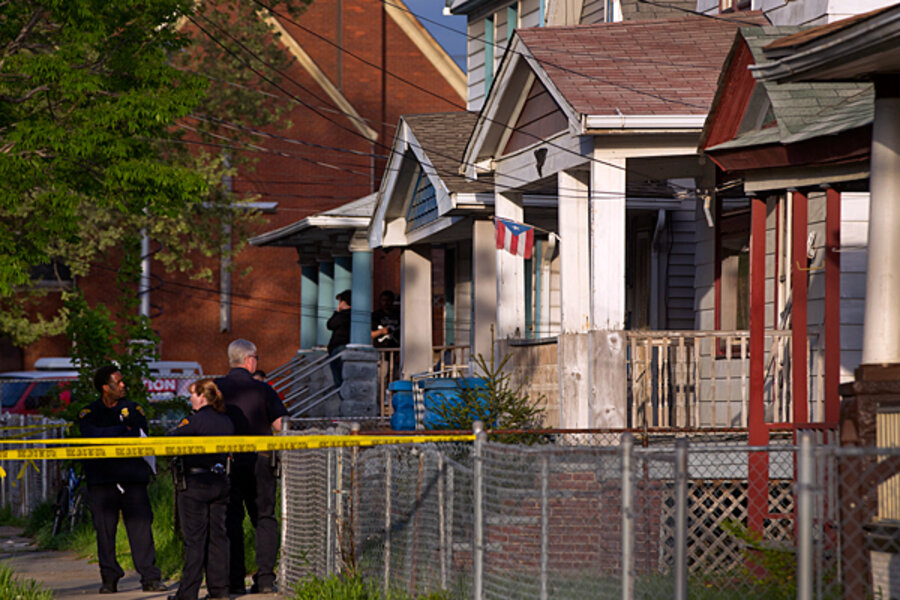Amanda Berry, two others found in Cleveland: the tale of how they escaped
Loading...
A desperate call for help and one frantic arm waving from the front door alerted neighbors that something was wrong on the west side of Cleveland on Monday evening.
"I heard screaming. I'm eating my McDonald's. I come outside. I see this girl going nuts trying to get out of a house,” Charles Ramsey, a neighbor, told WEWS-TV.
He went to the porch to investigate, and the woman asked him to help her get out. “I’ve been in here a long time,” she said. Mr. Ramsey couldn’t open the door, so he helped her kick out the bottom.
The woman emerged with a little girl and said, “Call 911. My name is Amanda Berry.”
So began the remarkable discovery of three women in Cleveland who had been held captive for about 10 years – just a few miles from where they disappeared.
Cleveland Police Chief Michael McGrath told reporters Monday that he thinks Ms. Berry, Gina DeJesus, and Michelle Knight had been tied up and held at a home on Seymour Avenue since they were in their teens or early 20s. Berry disappeared after her shift at a Burger King in April 2003, a day before her 17th birthday. Ms. DeJesus disappeared a year later, then 14 years old, on her way home from school. Ms. Knight disappeared in August 2002, when she was 20 years old.
When Berry emerged from the house Monday evening, she was wearing pajamas and old sandals. Other neighbors, including Anna Tejeda, were also drawn to the yells for help.
Ms. Tejeda said she wasn’t sure that the woman was Berry.
"You're not Amanda Berry," Tejada said. "Amanda Berry is dead."
Berry told her she had been kidnapped and held captive and needed a telephone to call the police.
"Help me. I'm Amanda Berry," she told a 911 dispatcher. "I've been kidnapped and I've been missing for 10 years and I'm, I'm here, I'm free now."
She asked the dispatcher to send police right away, “before he comes back,” referring to Ariel Castro, the man who police say owns the house where the women were found.
“I'm Amanda Berry,” she repeated. “I've been on the news for the last 10 years.”
Police arrived minutes later, and DeJesus and Knight came out of the house on their own, said Cleveland Deputy Police Chief Ed Tomba at a news conference Tuesday. Police arrested Mr. Castro and two of his brothers – Pedro Castro and Onil Castro – on Monday night.
Charlie Czorba, who lives on Seymour Avenue, told the Cleveland Plain Dealer that he was stunned by how long the women went undetected at the house.
"This is our own backyard," Mr. Czorba said. "These girls were locked up in our own backyard."
The Cleveland police and Federal Bureau of Investigation have followed numerous leads over the past decade, never going more than three months without a tip from the public or one of the families, said Stephen Anthony, FBI special agent in charge, at Tuesday’s press conference.
But none of those tips led investigators to the missing girls who are now women – until Berry escaped.
“The real hero here is Amanda,” said Tomba of the Cleveland police. “We are following her lead.”
McGrath said the first priority is the emotional well-being of the three women. Then the police will debrief them to learn exactly how the women came to the house and how they were treated during their captivity, he said Tuesday.
The three women were reunited with their families and treated at MetroHealth Medical Center Monday, and they appeared to be in good health.
"They are able to speak, they are safe, and hospital staff are assessing their needs," said Gerald Maloney, an emergency room physician, at a press briefing Monday. "This is good. This is not the ending we usually see from these stories. So we're very happy."
Investigators believe that the 6-year-old girl found in the house is Berry’s daughter, though they do not know who the father is, Tomba said.
"This is a great, great outcome that we have them still with us," he told reporters Monday. "It's just truly, truly amazing, and it's a blessing to the community and to the members of the police department and their families that they're alive. I can't tell you how happy we are."
• Material from The Associated Press contributed to this report.






